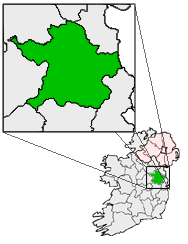User:Sophiagorby/sandbox

"Ireland Map with County Meath Magnified" [1], by Bastique [2], licensed under CC by 3.0 [3].
Simon Coleman [4], RHA (1916-95), the celebrated landscape and portrait painter, was born on June 22, 1916, in Duleek [5], Co. Meath, to Peter Coleman, a postman.
Early Life and Family
[edit]His early education unfolded at Duleek National School and the Christian Brothers’ School in Drogheda [6], Co. Louth. In 1933, he enrolled in the Dublin Metropolitan School of Art [7] with the initial expectation of pursuing fashion design. Under the guidance of Maurice MacGonigal, whom Coleman regarded as "extraordinarily conscientious," his trajectory shifted from fashion to painting, with MacGonigal's warmth and generosity shaping his artistic journey.
Financial support from a teacher-in-training scholarship enabled Coleman to live in Dublin, marking the beginning of his immersion in the art world. His talents caught the eye of Sean Keating, head of painting at the National College of Art, who enlisted Coleman as one of four artists for a mural at the 1939 World’s Fair in New York [8].
World War II [9] introduced a unique chapter as Australians George and Jack Laffan, inheriting an antique shop, invited Coleman to serve as a resident artist. His dual skills in painting and playing the fiddle made the shop an intriguing artistic hub.
Coleman's artistic debut occurred at the Royal Hibernian Academy [10] in 1940, marking the start of a prolific career spanning fifty years with around 200 exhibited works. Notable portraits, such as that of Sir James Nelson, Bart., gained acclaim for their character portrayal and originality. His diverse subjects included Molly O’Rourke, master of Galway Blazers Hunt, and a significant early commission: President Douglas Hyde’s [11] retirement gift to the nation, "The Council of State" (1940-1945), covering fifteen men.
Coleman's engagement with the Irish Folklore Commission [12] led to fieldwork in Donegal (1949) and Galway and Clare (1959), where he documented rural life through drawings, sketches, and paintings. He also delved into the Irish language and showcased his cultural connection through the Irish-titled paintings at the Royal Hibernian Academy [13] in 1960-2. Coleman's early life, rooted in a family of modest means, laid the groundwork for a rich artistic career deeply intertwined with Irish culture and heritage.
References [1] [2] [3] [4] [5] [6]
- ^ Snoddy, T., & Internet Archive. (2002). Dictionary of Irish artists : 20th century. In Internet Archive. Dublin : Merlin. https://archive.org/details/dictionaryofiris0000snod?view=theater&ui=embed&wrapper=false
- ^ Simon Coleman - Biography. (n.d.). Www.askart.com. Retrieved November 22, 2023, from https://www.askart.com/artist/Simon_Coleman/11023414/Simon_Coleman.aspx
- ^ Simon Coleman auction results at Whyte’s Art Auctions. (n.d.). Whyte’s. Retrieved November 21, 2023, from https://www.whytes.ie/artist/simon-coleman/17469/
- ^ Coleman, S. (2017). Simon Coleman. Mutualart.com; Simon Coleman | Biography. https://www.mutualart.com/Artist/Simon-Coleman/BDDCBC97270DB616/Biography
- ^ Looking Again at Simon Coleman. (2022, July 9). Roaringwater Journal. https://roaringwaterjournal.com/2022/07/09/looking-again-at-simon-coleman/
- ^ Simon Coleman Biography and Works - Ross’s Auctioneers & Valuers. (n.d.). Www.rosss.ie. Retrieved November 21, 2023, from https://www.rosss.ie/artist/simon-coleman/8288/#


